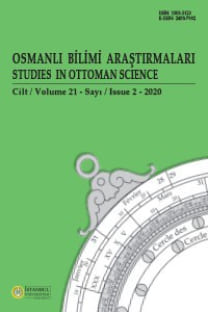Yaycı Yusuf Beşe Terekesinin Düşündürdükleri
The article is based on a court record dated 1705, and is about the inheritance of a Janissary bowmaker, Yusuf Beshe. This document reveals the bows made in 17th-18th century İstanbul, the tools and the materials a bowery needed and their cost. This information not only confirms our knowledge about the traditional Turkish bowmaking technique, but the related material and tools. It also proves that Crimean Tartar bows were made in the Ottoman capital city. Crimean Tartars were the allies of the Ottomans and contributed the Ottoman army in the battle as fronteers. This document shows that these bows that are structurally different from the classical Ottoman bows, were also made in İstanbul, a fact that would bring an explanation to some old reports about longdraw Turkish bows. Another important point about Turkish bowmaking history is a bow type called the Mameluke bow which had not been mentioned yet in known sources. This article provides an evidence-based analysis about its possible identity and its use.
Anahtar Kelimeler:
Osmanlı yayı, Kırım Tatar yayı, balık tutkalı, yay-ı Mısrî, Türk yaycılığı, okçuluk, yay, ok
Inheritance record of Yusuf Beshe, an Ottoman bowmaker of late 17th century
The article is based on a court record dated 1705, and is about the inheritance of a Janissary bowmaker, Yusuf Beshe. This document reveals the bows made in 17th-18th century İstanbul, the tools and the materials a bowery needed and their cost. This information not only confirms our knowledge about the traditional Turkish bowmaking technique, but the related material and tools. It also proves that Crimean Tartar bows were made in the Ottoman capital city. Crimean Tartars were the allies of the Ottomans and contributed the Ottoman army in the battle as fronteers. This document shows that these bows that are structurally different from the classical Ottoman bows, were also made in İstanbul, a fact that would bring an explanation to some old reports about longdraw Turkish bows. Another important point about Turkish bowmaking history is a bow type called the Mameluke bow which had not been mentioned yet in known sources. This article provides an evidence-based analysis about its possible identity and its use.
Keywords:
Ottoman bow, Crimean-Tartar bow, fish glue, Mameluke bow, Turkish bowery, archery, bow, arrow,
___
- -
- ISSN: 1303-3123
- Yayın Aralığı: Yılda 2 Sayı
- Başlangıç: 1995
- Yayıncı: İstanbul Üniversitesi Edebiyat Fakültesi
Sayıdaki Diğer Makaleler
Hofrat Prof.Carl Haussknecht'in (1838-1903) Türkiye bitkileri koleksiyonu
Astronomik Düzenlilikten Sosyo-Matematik Uylaşıma Takvim
Anadolu Kültüründe Kilit (Doğu Ve Güneydoğu Anadolu Örnekleri)
Semra SARAÇOĞLU, Bülent KARAKAŞ
Hititlerin Astronomi Bilgisine Ve Hitit Takvimine Bir Bakış
Osmanlı Teknoloji Tarihinden Bir Kesit: Gemi İndirme Yöntemleri
Prof. Kurt Krause'nin (1883-1963) Türkiye Florası İle İlgili Gezilerı ve Yayınları
Deneylerle Elektriği Tanıtan Bir Türkçe Eser: Yahya Naci Efendi’nin Risale-i Seyyale-i Berkiyye’si
Elektrik Mühendisi Mehmet Refik Fenmen: Osmanlı’dan Cumhuriyet’e Yenilikçi ve Yorulmaz Bir Aydın
